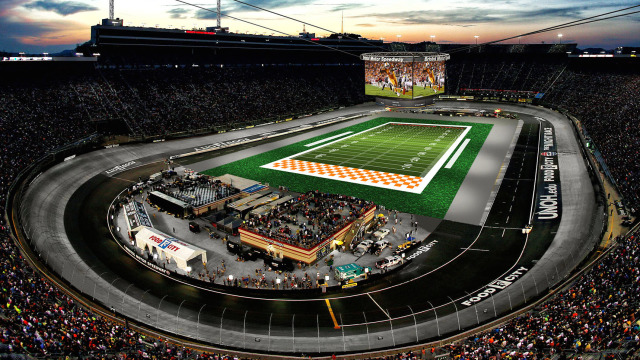 When the University of Tennessee and Virginia Tech knock heads on the gridiron September 10th, the matchup will consummate one of the biggest game site transformations in all of sports.
When the University of Tennessee and Virginia Tech knock heads on the gridiron September 10th, the matchup will consummate one of the biggest game site transformations in all of sports.
And, a record college football crowd will be on hand – as well as watching on television – to witness the largest attended game in college football history.
That night, near the Tennessee-Virginia border, the famous Bristol Motor Speedway, known around the world as “The Last Great Colosseum,” will host the “Pilot Flying J Battle at Bristol,” a throw down between the two college football border rivals.
Since news of the matchup first broke three years ago, the game has captured headlines and intrigued audiences across the globe. According to BMS officials, ticketholders from all 50 states, the District of Columbia and several foreign countries will be in attendance to shatter the existing world record for the largest American football game. With an expected crowd of more than 150,000 (more than double the attendance of this year’s Super Bowl) the game will surpass the previous record attendance for a college football game by over 40,000 people.
Enthusiastic fans will watch as Butch Jones’ Top-10 ranked Tennessee Volunteers take on the Hokies and their first-year head coach Justin Fuente in the prime time matchup on ABC at 8pm. But, before all of those fans arrive and the pigskin is placed on the tee, a whole lot of transformational magic will have already taken place. Indeed the scope of the work is spectacular.
Bristol Motor Speedway is exactly that – a speedway. The asphalt and concrete race track and infield went through a quick transformation after the NASCAR Sprint Cup Race on August 20th. Things got squeezed even tighter when the Night Race faced a rain postponement on that Saturday and had to be finished on Sunday afternoon as the rain forced additional delays. Once Kevin Harvick took the checkered flag, the wheels started rolling to make The Colosseum a football venue.
That leaves only 19 days to complete a mind-boggling list of projects that includes tidying up the stadium and grounds, building out the playing surface, adding more than 5,000 premium seats to the infield, installing goal posts, clocks and cameras, and assembling massive concert stages and VIP fan zones.
Overseeing the makeover is the job of Jerry Caldwell, executive vice president and general manager of Bristol Motor Speedway.
“Making the transition in just 19 days will be tight, but we’re used to tackling the challenge,” said Caldwell earlier in August. “We know what it’s like to stretch and achieve these larger-than-life events, and I think when people see the field in September, it will look and feel very natural. Our first-time guests will never guess that the last time a football game was played here, JFK was president.”
The transformation has been in the planning for years.
When asked what it was like to race at BMS at the August Night Race, NASCAR legend and nine-time Bristol winner Rusty Wallace once said, “When they turn the lights on at that place, all hell breaks loose.”
On August 20th, the lights came on and stayed on long after the checkered flag, and the work began. Crews immediately stormed the stadium after the Night Race to clean and power wash the stadium, buildings and infield. The first step in building up the field body was a heavy-duty field barrier. The infield at BMS is slightly concave and dotted with drains. To prevent tons of material from disappearing into the plumbing, the barrier had to be rolled over the infield.
Next, 450 truckloads of rock and manufactured sand for the field base were delivered, weighing in at more than 10,600 tons. Using site-measurement technology, crews compacted the field base to millimeter-level accuracy, rising to a finished height of more than three feet.
At the same time, the Infield Media Center, the Goodyear Tire Building and Victory Lane were transformed into team and referee locker rooms and meeting spaces.
Addition of the AstroTurf field body green was completed in late-August – a state-of-the-art artificial turf that features infill stabilization and texturized layers of fiber that curls down into the surface to reduce splash during play and provide grass-like traction for players. This involved installing over 100,000 square feet of surface to a height of 1.5 inches, using more than 180,000 pounds each of silica and rubber infill.
Beginning August 29th, the finishing touches on the field including sidelines, yard markers and hashes were added. By September 1st, the areas around BMS were groomed for the big event and then finally, on game week, specialist from both universities added logos and stenciling.
All in place for game day, and the most anticipated game in college football in maybe forever.
Can the Hokies pull out the big upset in front of the largest crowd ever?
Stay tuned.
Bill Turner

